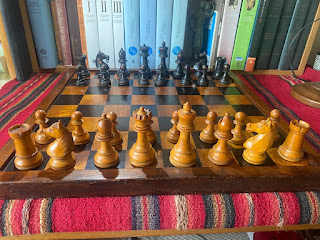Soviet, Tal and Fischer Lardy Chess Sets: Featuring Chuck Grau

Lardy Set Played on by Fischer (Courtesy of C. Grau)

Introduction:
Welcome to our blog, where we delve into the intriguing realm of chess collecting. In this special edition, we had the opportunity to sit down with renowned chess collector, Chuck Grau. Chuck's passion for chess and his extensive collection of unique sets have made him a prominent figure in the chess collecting community. Our conversation with Chuck provided valuable insights into his journey as a chess enthusiast and shed light on the fascinating stories behind some of his most prized possessions.
Part 1: A Rediscovery of Chess
Chuck begins by sharing how his journey into the world of chess collecting started. He fondly recalls his early days as a chess player, participating in tournaments during the 1960s. However, life took him in a different direction, and he took a hiatus from the game for over three decades. It was his son's request to learn chess that reignited Chuck's passion for the game.
As Chuck began teaching his son, he rediscovered the joy of playing and found himself captivated by the artistry of chess sets. With the rise of online marketplaces like eBay, he started exploring different chess sets and acquiring unique pieces. Among his early acquisitions were Staunton reproductions and sets from House of Staunton. Chuck's collection gradually expanded, reflecting his growing fascination with the intricate designs and historical significance of chess sets.
A Fateful Encounter:
During our conversation, Chuck reminisces about a significant turning point in his chess collecting journey. He describes a chance encounter with a Russian chess set that caught his attention while perusing Mikhail Tal's autobiography. The set's unique aesthetic and historical association piqued Chuck's curiosity, prompting him to embark on a search to acquire it.
Chuck's search for this elusive Russian chess set spanned several years. Frustrated by the scarcity of information, he considered commissioning a custom reproduction from a renowned chess set manufacturer. However, he also explored alternative avenues and reached out to the team at NOJ in Ljubljana, Slovenia, who specialized in Dubrovnik reproductions.
A Collaborative Effort:
Chuck's email to NOJ sparked a collaboration that lasted six months. Together with his friend Phil and Gregor Novak from NOJ, they meticulously analyzed photographs, shared shop drawings, and worked tirelessly to resurrect the iconic Russian chess set. The reproduction they created was a testament to their shared passion, attention to detail, and dedication to preserving chess history.
The resulting reproduction, which Chuck proudly showcases during our interview, stands as a personal favorite among his collection. He explains that this set represents more than just its aesthetic appeal. It symbolizes the collaborative effort and the deep appreciation he has for the history and stories embedded within each chess set.
A Connection to the Game:
Chuck emphasizes his preference for tournament sets in his collection, citing his love for the connection they establish with the game and its players. He relishes the opportunity to play on these sets, envisioning the countless games played by Grandmasters in tournaments past. The historical connection and the artistry of the sets intertwine, creating a rich tapestry that continues to inspire his passion for chess collecting.
As our conversation with Chuck unfolds, we delve further into his collection, exploring more intriguing chess sets and the stories behind them. Stay tuned for the next part of our interview, where we unravel the tales of other remarkable sets and delve deeper into Chuck's experiences as a chess collector.
Baku-Style Chess Sets:
During our conversation, I mentioned a piece that Chuck had written about Russian Chess Collections, specifically highlighting Baku-style chess sets. Chuck confirmed that the set I had read about was indeed a Baku-style set, featuring angular knights and unique geometric designs. He emphasized the fascinating combination of artistic design ideas and practical considerations found in these sets.
Chuck explained that Baku sets have conical base stem structures, which distribute the weight towards the bottom of the pieces. This design allows for the use of minimal or no metal to weigh down the pieces. He admired the geometric and elongated features of the bishops and the distinct crown structure of the kings.
SovietChessSets.com:
Chuck shared his website, SovietChessSets.com, which is dedicated to Soviet chess sets. He mentioned having around 35 articles posted on the website, exploring various chess sets and their connections to chess in the Soviet Union, as well as broader topics like economics, sociology, art theory, and the history of the Soviet Union.
Chuck's website aims to provide a comprehensive understanding of Soviet chess sets by placing them in the context of Soviet society. His articles delve into the artistic, historical, and sociological aspects of these sets, offering readers a deeper appreciation for their significance.
Collecting Chess Sets and Bobby Fischer:
As we continued our conversation, Chuck shared a fascinating story about a Bobby Fischer chess set he acquired. He mentioned meeting a seller who believed the set to be a Russian heirloom, passed down from his father who had allegedly played against Bobby Fischer in the mid-1960s.
Curious about the authenticity of the story, Chuck researched the event and found three newspaper articles from May 1964 that chronicled Fischer's simultaneous exhibition in Indianapolis. The seller was thrilled to see a picture of his father and himself in one of the articles, confirming the historical significance of the set.
Chuck's love for chess extended beyond collecting chess sets. He expressed admiration for Bobby Fischer as his favorite chess player, despite Fischer's well-known eccentricities. Chuck reminisced about growing up in the 1960s, when Fischer and the Soviet players were dominant figures in the chess world.
Returning to Chess:
Although Chuck hadn't played in a tournament since 2008, he contemplated getting back into competitive chess. He mentioned being drawn to the intellectual aspects of the game and the opportunity it provides for deep contemplation. He also acknowledged the tactile and aesthetic beauty of physical chess sets, as opposed to playing online.
Chuck mentioned his interest in chess.com and other online platforms but acknowledged that the experience differs from the tactile feel of physical pieces. He appreciated the artistry and interactive nature of chess sets, which offer a unique sensory experience and a connection to the game that transcends the virtual realm.
Conclusion:
In conclusion, my interview with Chuck Grau was truly insightful and inspiring. His passion for Soviet chess sets, coupled with his knowledge of chess history, added depth to our conversation. From exploring the unique features of Baku-style sets to discussing his website SovietChessSets.com, Chuck's expertise and enthusiasm shone through.
Chess, for Chuck, is not just a game but a form of art that encapsulates intellectual engagement and aesthetic appreciation. I hope you enjoyed this interview as much as I did, and I encourage you to visit SovietChessSets.com to explore the rich world of Soviet chess sets.
Thank you for joining me on this fascinating journey into the world of chess and Soviet chess sets. If you have any comments or insights, please feel free to share them in the video comments. Stay tuned for more exciting content in the future!



Comments
Post a Comment